Analysis of GM and Ford's International Business Strategies (MGT302)
VerifiedAdded on 2022/11/14
|17
|1880
|321
Report
AI Summary
This report analyzes the international business strategies of General Motors (GM) and Ford, focusing on their ventures in the Chinese market and their global platform strategies. The GM section examines the company's successful joint venture with SAIC, its attraction to the Chinese market's potential, the reasons behind the joint venture, potential risks, and the factors contributing to its success. It also explores GM's increased commitment to China and offers personal reflections on the company's approach. The Ford section discusses the company's global platform strategy, the strategies used before Alan Mullaly, the benefits of a standardized platform, and recommendations for Ford's strategy. The report also includes a personal reflection on the importance of platform standardization and the sharing of building platforms to standardize operations.
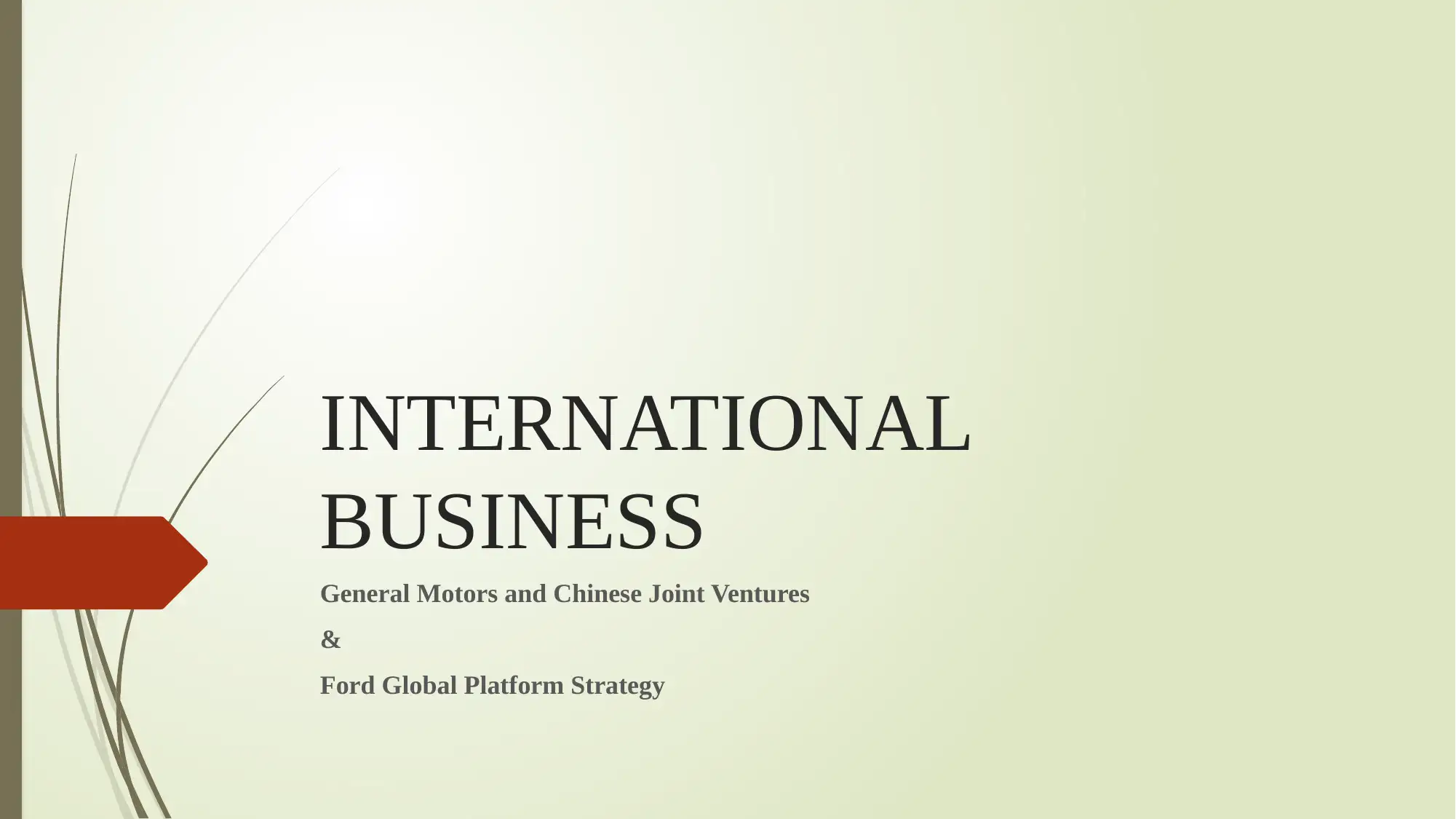
INTERNATIONAL
BUSINESS
General Motors and Chinese Joint Ventures
&
Ford Global Platform Strategy
BUSINESS
General Motors and Chinese Joint Ventures
&
Ford Global Platform Strategy
Paraphrase This Document
Need a fresh take? Get an instant paraphrase of this document with our AI Paraphraser
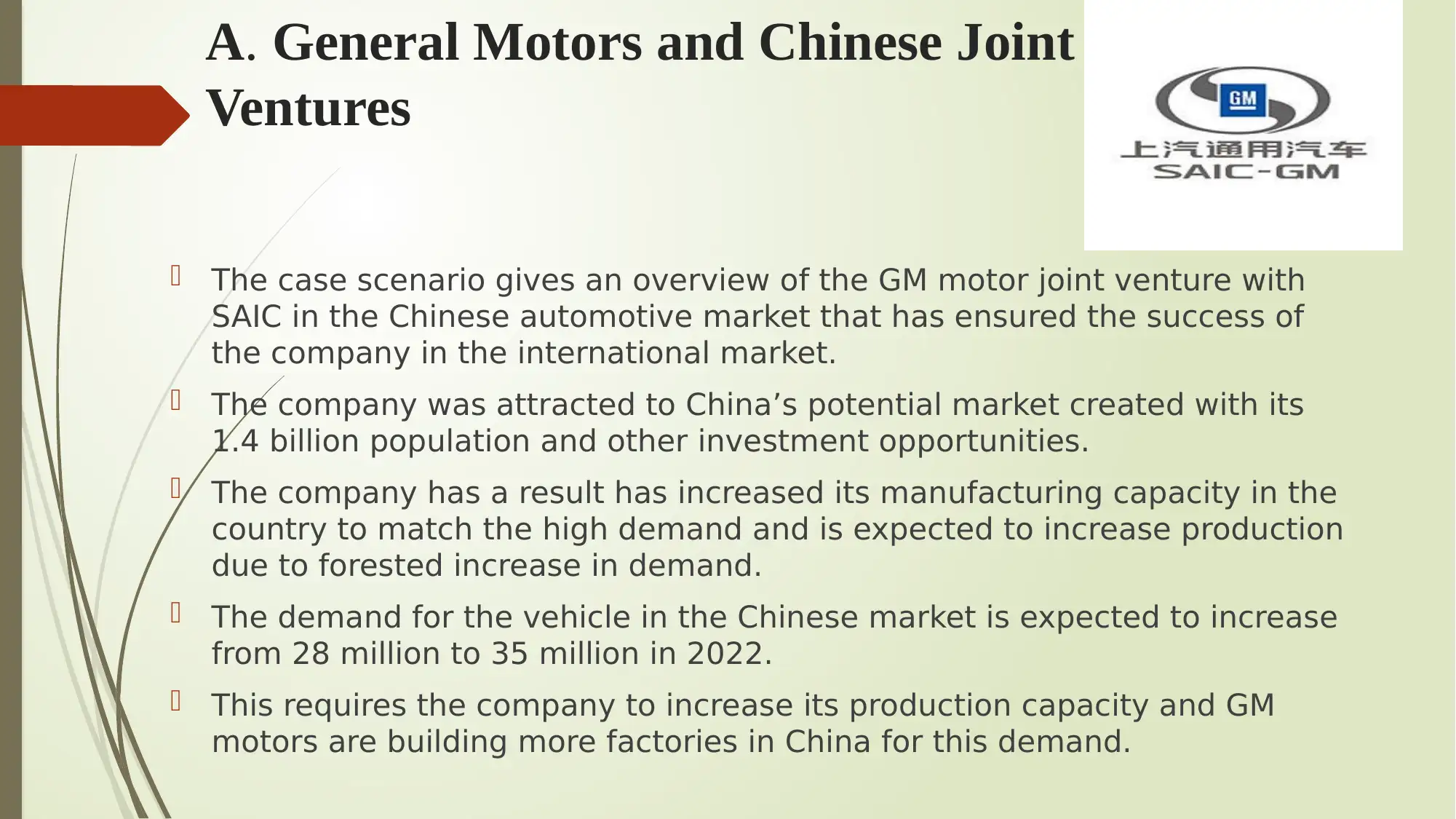
A. General Motors and Chinese Joint
Ventures
The case scenario gives an overview of the GM motor joint venture with
SAIC in the Chinese automotive market that has ensured the success of
the company in the international market.
The company was attracted to China’s potential market created with its
1.4 billion population and other investment opportunities.
The company has a result has increased its manufacturing capacity in the
country to match the high demand and is expected to increase production
due to forested increase in demand.
The demand for the vehicle in the Chinese market is expected to increase
from 28 million to 35 million in 2022.
This requires the company to increase its production capacity and GM
motors are building more factories in China for this demand.
Ventures
The case scenario gives an overview of the GM motor joint venture with
SAIC in the Chinese automotive market that has ensured the success of
the company in the international market.
The company was attracted to China’s potential market created with its
1.4 billion population and other investment opportunities.
The company has a result has increased its manufacturing capacity in the
country to match the high demand and is expected to increase production
due to forested increase in demand.
The demand for the vehicle in the Chinese market is expected to increase
from 28 million to 35 million in 2022.
This requires the company to increase its production capacity and GM
motors are building more factories in China for this demand.
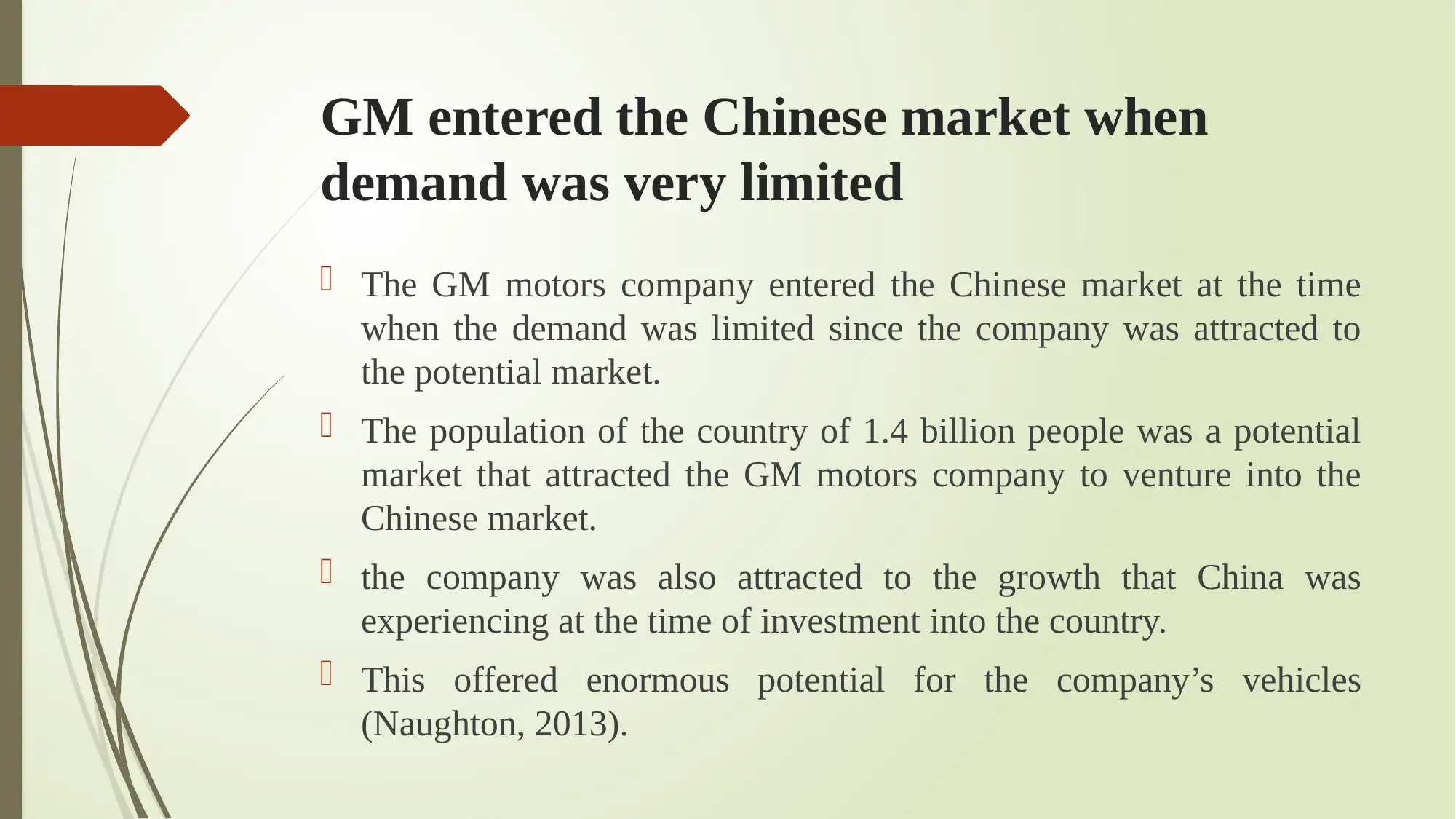
GM entered the Chinese market when
demand was very limited
The GM motors company entered the Chinese market at the time
when the demand was limited since the company was attracted to
the potential market.
The population of the country of 1.4 billion people was a potential
market that attracted the GM motors company to venture into the
Chinese market.
the company was also attracted to the growth that China was
experiencing at the time of investment into the country.
This offered enormous potential for the company’s vehicles
(Naughton, 2013).
demand was very limited
The GM motors company entered the Chinese market at the time
when the demand was limited since the company was attracted to
the potential market.
The population of the country of 1.4 billion people was a potential
market that attracted the GM motors company to venture into the
Chinese market.
the company was also attracted to the growth that China was
experiencing at the time of investment into the country.
This offered enormous potential for the company’s vehicles
(Naughton, 2013).
⊘ This is a preview!⊘
Do you want full access?
Subscribe today to unlock all pages.

Trusted by 1+ million students worldwide
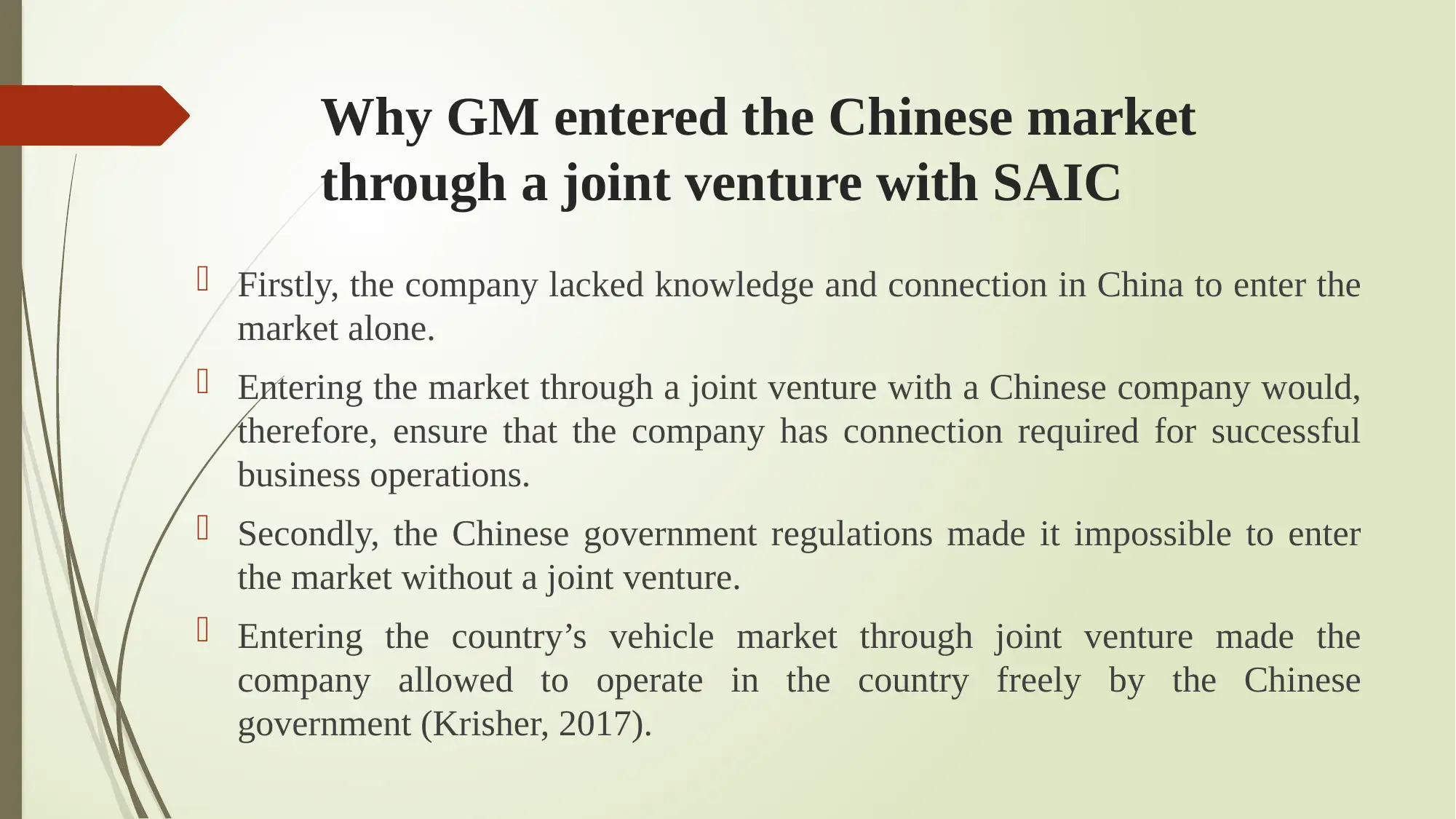
Why GM entered the Chinese market
through a joint venture with SAIC
Firstly, the company lacked knowledge and connection in China to enter the
market alone.
Entering the market through a joint venture with a Chinese company would,
therefore, ensure that the company has connection required for successful
business operations.
Secondly, the Chinese government regulations made it impossible to enter
the market without a joint venture.
Entering the country’s vehicle market through joint venture made the
company allowed to operate in the country freely by the Chinese
government (Krisher, 2017).
through a joint venture with SAIC
Firstly, the company lacked knowledge and connection in China to enter the
market alone.
Entering the market through a joint venture with a Chinese company would,
therefore, ensure that the company has connection required for successful
business operations.
Secondly, the Chinese government regulations made it impossible to enter
the market without a joint venture.
Entering the country’s vehicle market through joint venture made the
company allowed to operate in the country freely by the Chinese
government (Krisher, 2017).
Paraphrase This Document
Need a fresh take? Get an instant paraphrase of this document with our AI Paraphraser
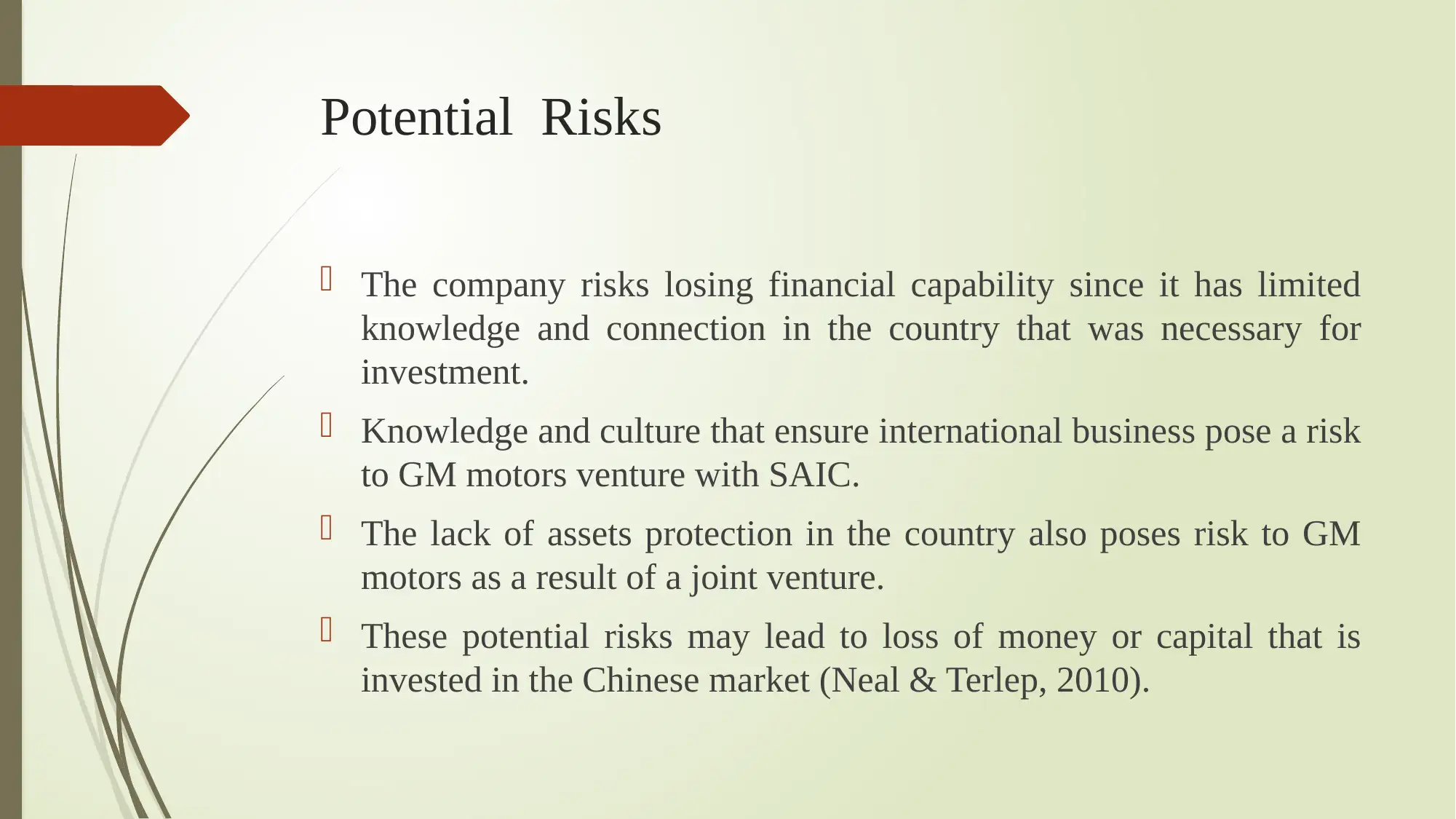
Potential Risks
The company risks losing financial capability since it has limited
knowledge and connection in the country that was necessary for
investment.
Knowledge and culture that ensure international business pose a risk
to GM motors venture with SAIC.
The lack of assets protection in the country also poses risk to GM
motors as a result of a joint venture.
These potential risks may lead to loss of money or capital that is
invested in the Chinese market (Neal & Terlep, 2010).
The company risks losing financial capability since it has limited
knowledge and connection in the country that was necessary for
investment.
Knowledge and culture that ensure international business pose a risk
to GM motors venture with SAIC.
The lack of assets protection in the country also poses risk to GM
motors as a result of a joint venture.
These potential risks may lead to loss of money or capital that is
invested in the Chinese market (Neal & Terlep, 2010).
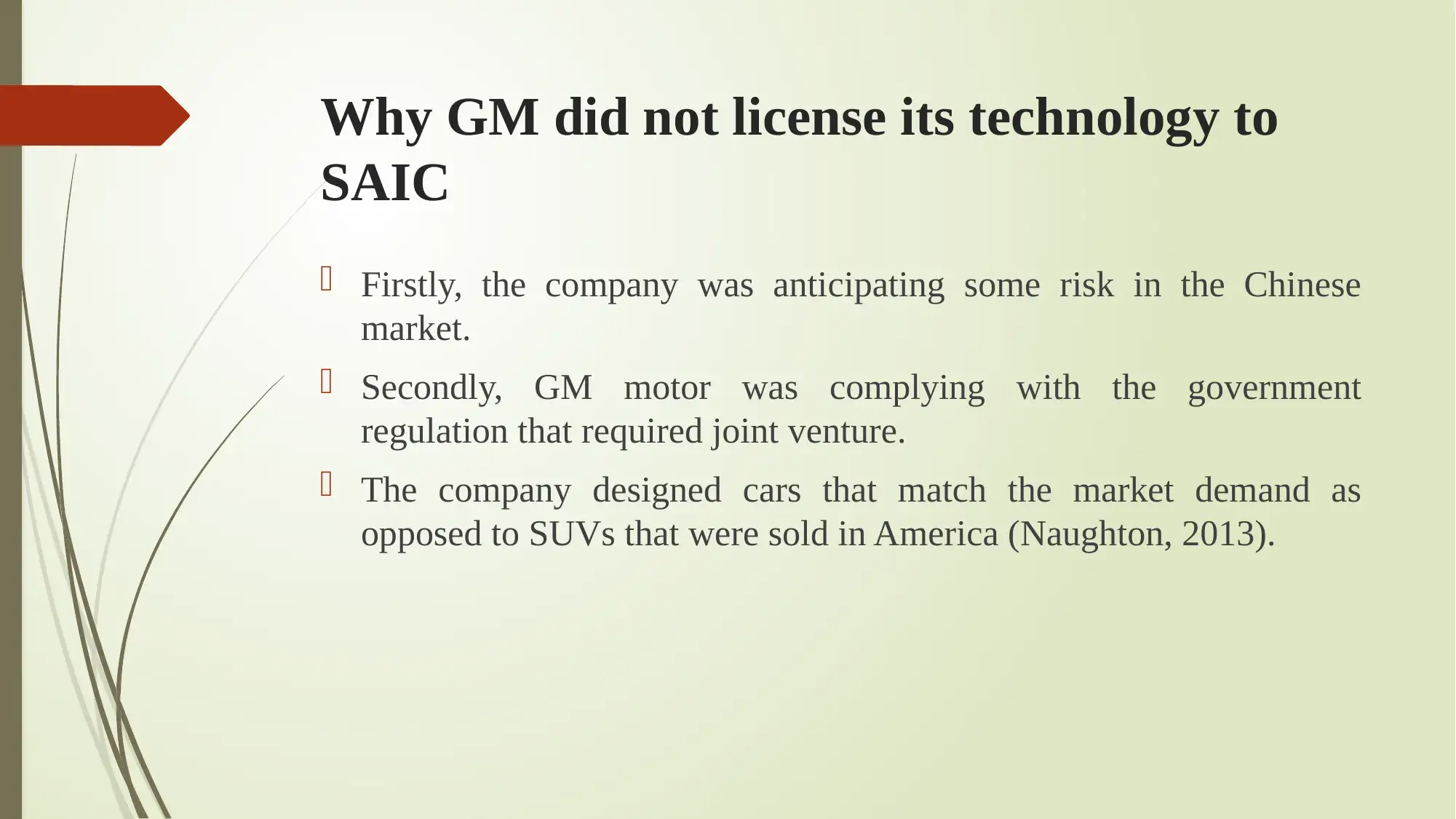
Why GM did not license its technology to
SAIC
Firstly, the company was anticipating some risk in the Chinese
market.
Secondly, GM motor was complying with the government
regulation that required joint venture.
The company designed cars that match the market demand as
opposed to SUVs that were sold in America (Naughton, 2013).
SAIC
Firstly, the company was anticipating some risk in the Chinese
market.
Secondly, GM motor was complying with the government
regulation that required joint venture.
The company designed cars that match the market demand as
opposed to SUVs that were sold in America (Naughton, 2013).
⊘ This is a preview!⊘
Do you want full access?
Subscribe today to unlock all pages.

Trusted by 1+ million students worldwide
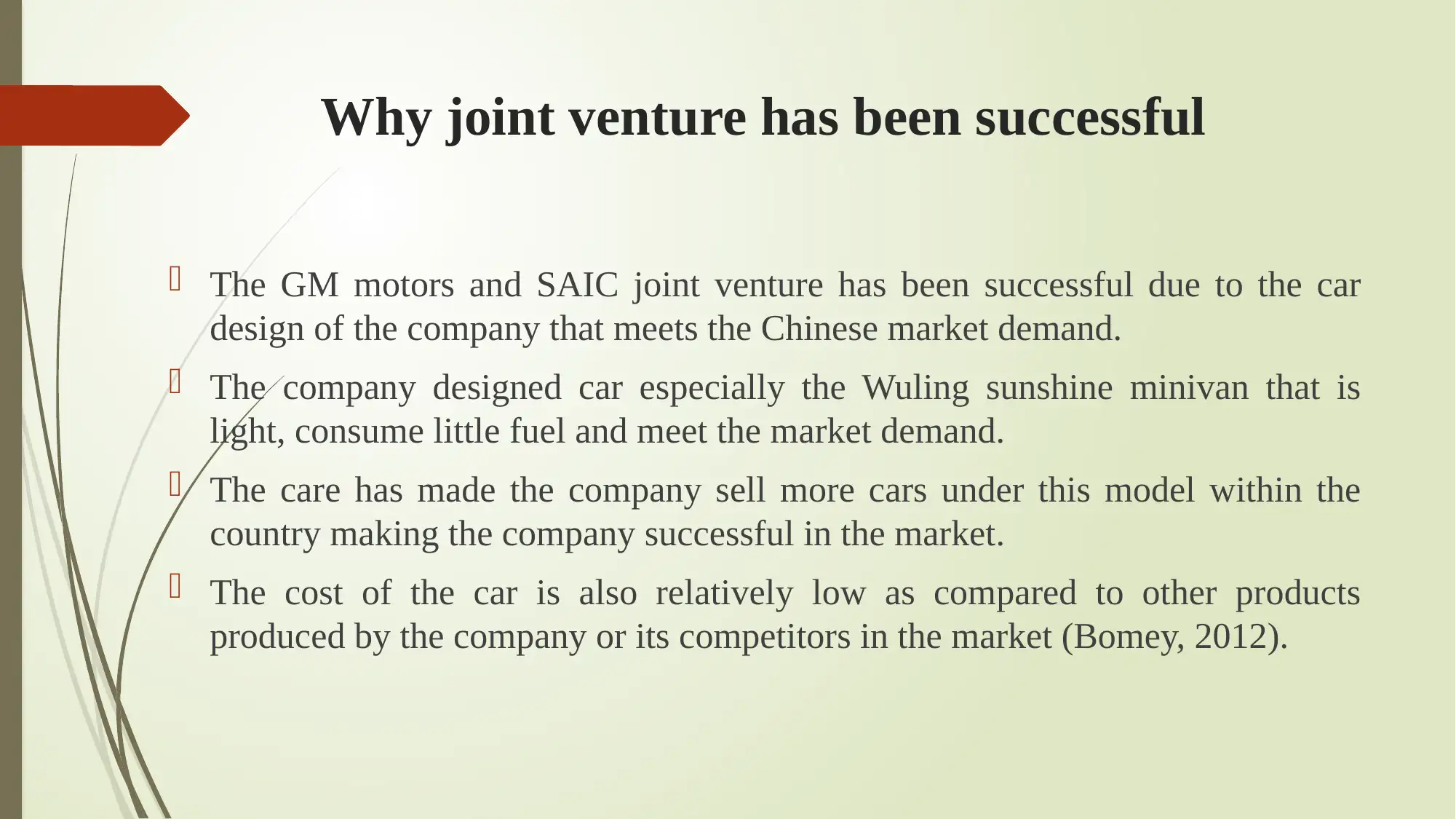
Why joint venture has been successful
The GM motors and SAIC joint venture has been successful due to the car
design of the company that meets the Chinese market demand.
The company designed car especially the Wuling sunshine minivan that is
light, consume little fuel and meet the market demand.
The care has made the company sell more cars under this model within the
country making the company successful in the market.
The cost of the car is also relatively low as compared to other products
produced by the company or its competitors in the market (Bomey, 2012).
The GM motors and SAIC joint venture has been successful due to the car
design of the company that meets the Chinese market demand.
The company designed car especially the Wuling sunshine minivan that is
light, consume little fuel and meet the market demand.
The care has made the company sell more cars under this model within the
country making the company successful in the market.
The cost of the car is also relatively low as compared to other products
produced by the company or its competitors in the market (Bomey, 2012).
Paraphrase This Document
Need a fresh take? Get an instant paraphrase of this document with our AI Paraphraser
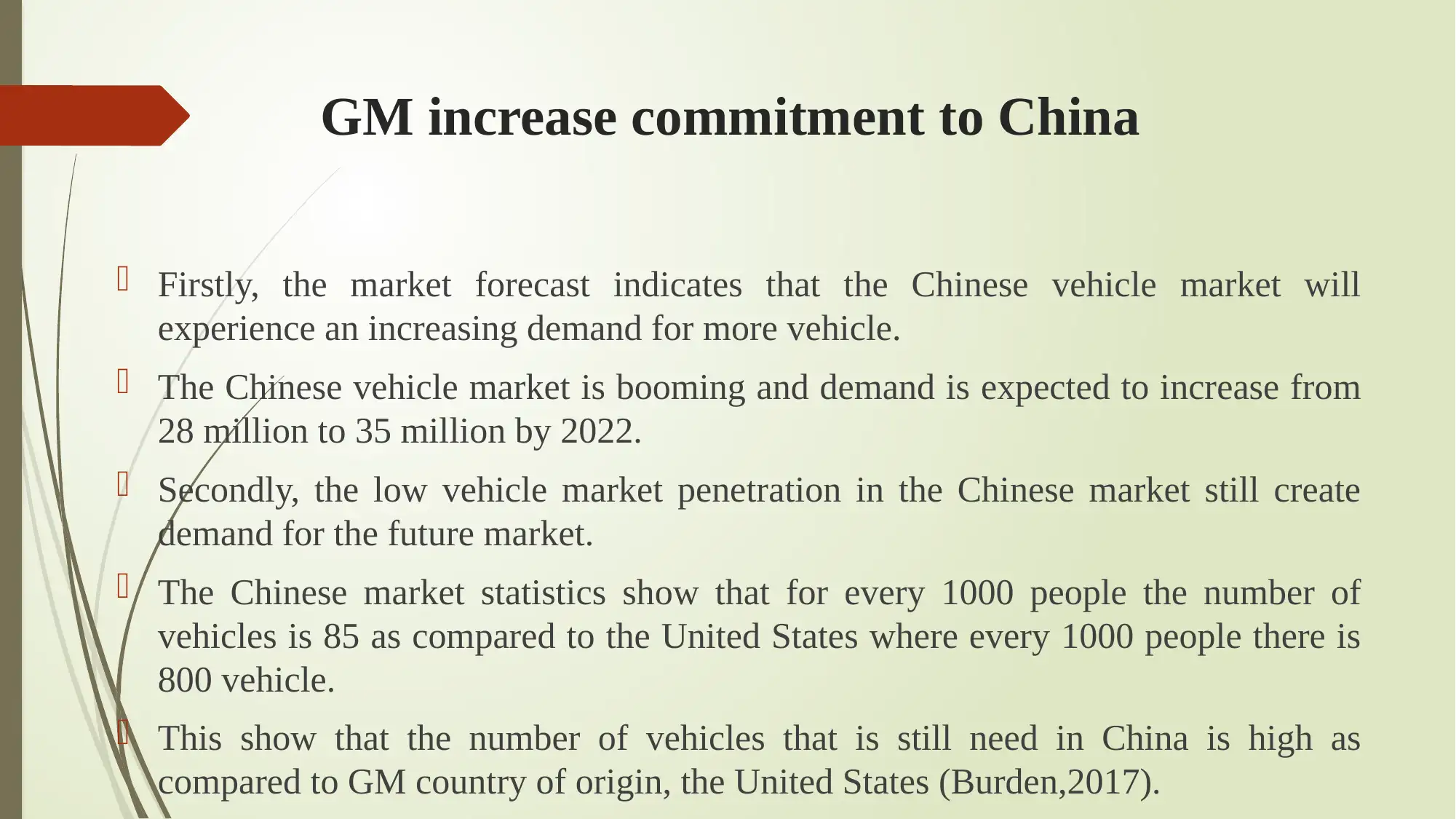
GM increase commitment to China
Firstly, the market forecast indicates that the Chinese vehicle market will
experience an increasing demand for more vehicle.
The Chinese vehicle market is booming and demand is expected to increase from
28 million to 35 million by 2022.
Secondly, the low vehicle market penetration in the Chinese market still create
demand for the future market.
The Chinese market statistics show that for every 1000 people the number of
vehicles is 85 as compared to the United States where every 1000 people there is
800 vehicle.
This show that the number of vehicles that is still need in China is high as
compared to GM country of origin, the United States (Burden,2017).
Firstly, the market forecast indicates that the Chinese vehicle market will
experience an increasing demand for more vehicle.
The Chinese vehicle market is booming and demand is expected to increase from
28 million to 35 million by 2022.
Secondly, the low vehicle market penetration in the Chinese market still create
demand for the future market.
The Chinese market statistics show that for every 1000 people the number of
vehicles is 85 as compared to the United States where every 1000 people there is
800 vehicle.
This show that the number of vehicles that is still need in China is high as
compared to GM country of origin, the United States (Burden,2017).
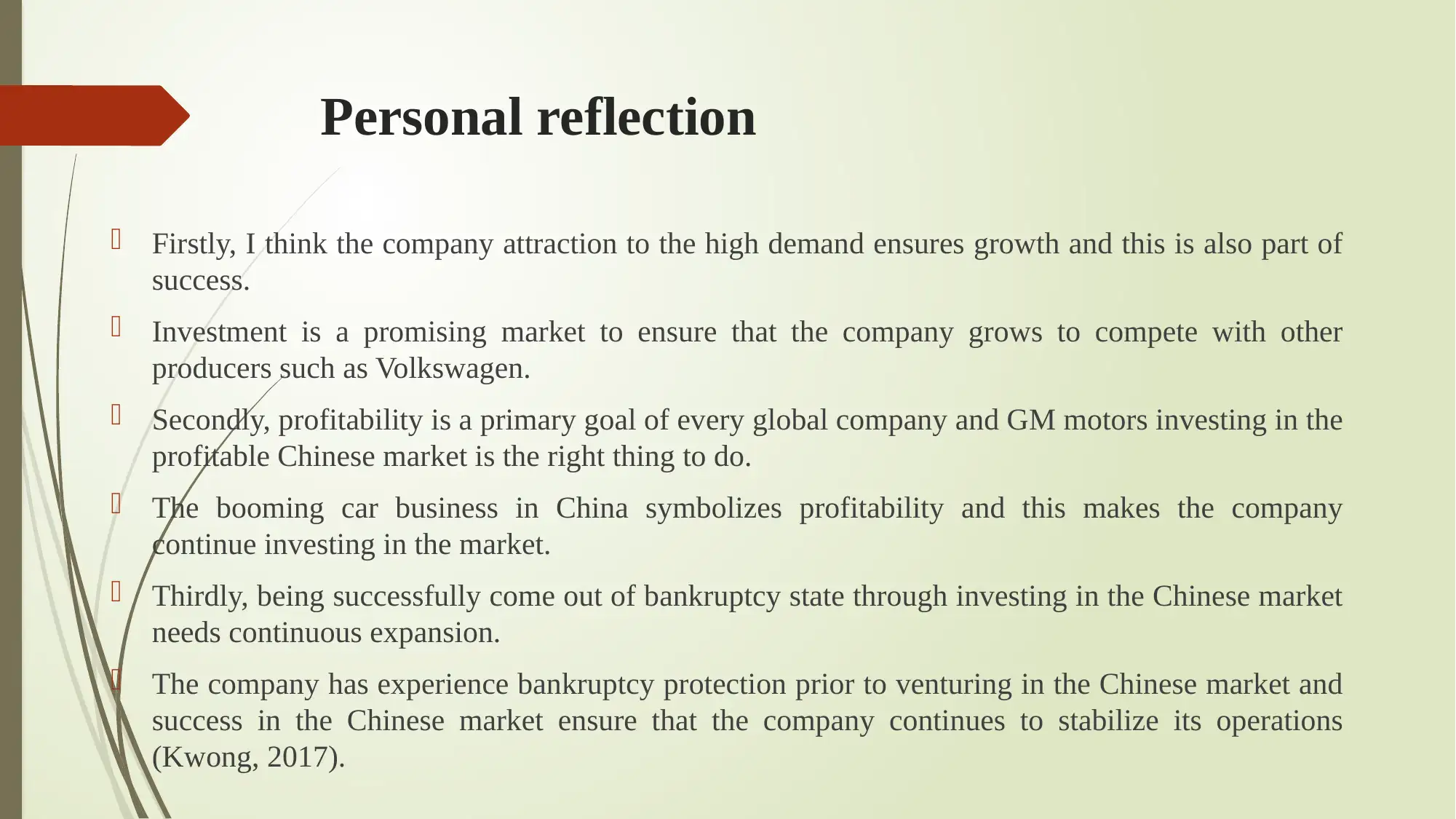
Personal reflection
Firstly, I think the company attraction to the high demand ensures growth and this is also part of
success.
Investment is a promising market to ensure that the company grows to compete with other
producers such as Volkswagen.
Secondly, profitability is a primary goal of every global company and GM motors investing in the
profitable Chinese market is the right thing to do.
The booming car business in China symbolizes profitability and this makes the company
continue investing in the market.
Thirdly, being successfully come out of bankruptcy state through investing in the Chinese market
needs continuous expansion.
The company has experience bankruptcy protection prior to venturing in the Chinese market and
success in the Chinese market ensure that the company continues to stabilize its operations
(Kwong, 2017).
Firstly, I think the company attraction to the high demand ensures growth and this is also part of
success.
Investment is a promising market to ensure that the company grows to compete with other
producers such as Volkswagen.
Secondly, profitability is a primary goal of every global company and GM motors investing in the
profitable Chinese market is the right thing to do.
The booming car business in China symbolizes profitability and this makes the company
continue investing in the market.
Thirdly, being successfully come out of bankruptcy state through investing in the Chinese market
needs continuous expansion.
The company has experience bankruptcy protection prior to venturing in the Chinese market and
success in the Chinese market ensure that the company continues to stabilize its operations
(Kwong, 2017).
⊘ This is a preview!⊘
Do you want full access?
Subscribe today to unlock all pages.

Trusted by 1+ million students worldwide
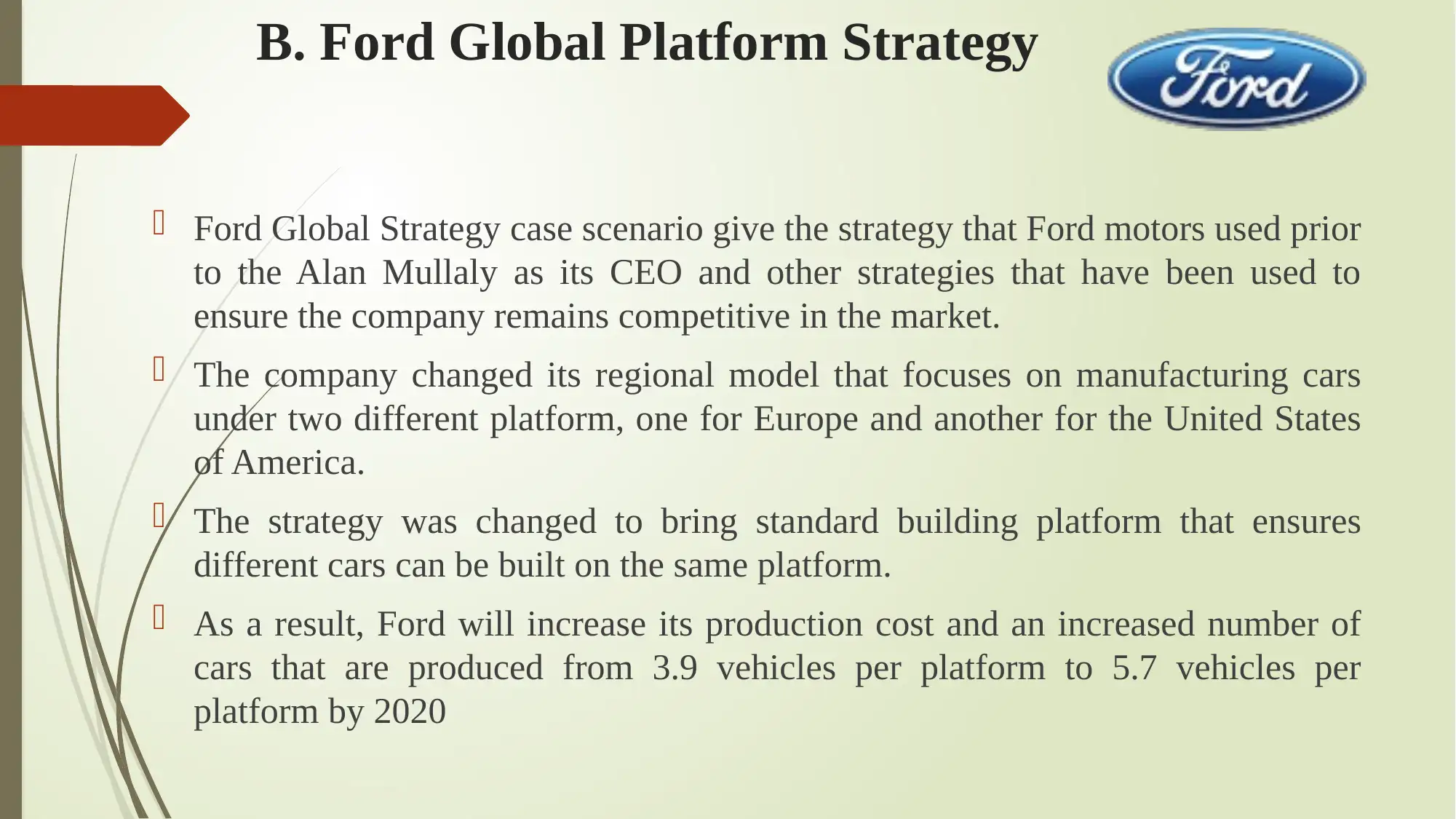
B. Ford Global Platform Strategy
Ford Global Strategy case scenario give the strategy that Ford motors used prior
to the Alan Mullaly as its CEO and other strategies that have been used to
ensure the company remains competitive in the market.
The company changed its regional model that focuses on manufacturing cars
under two different platform, one for Europe and another for the United States
of America.
The strategy was changed to bring standard building platform that ensures
different cars can be built on the same platform.
As a result, Ford will increase its production cost and an increased number of
cars that are produced from 3.9 vehicles per platform to 5.7 vehicles per
platform by 2020
Ford Global Strategy case scenario give the strategy that Ford motors used prior
to the Alan Mullaly as its CEO and other strategies that have been used to
ensure the company remains competitive in the market.
The company changed its regional model that focuses on manufacturing cars
under two different platform, one for Europe and another for the United States
of America.
The strategy was changed to bring standard building platform that ensures
different cars can be built on the same platform.
As a result, Ford will increase its production cost and an increased number of
cars that are produced from 3.9 vehicles per platform to 5.7 vehicles per
platform by 2020
Paraphrase This Document
Need a fresh take? Get an instant paraphrase of this document with our AI Paraphraser
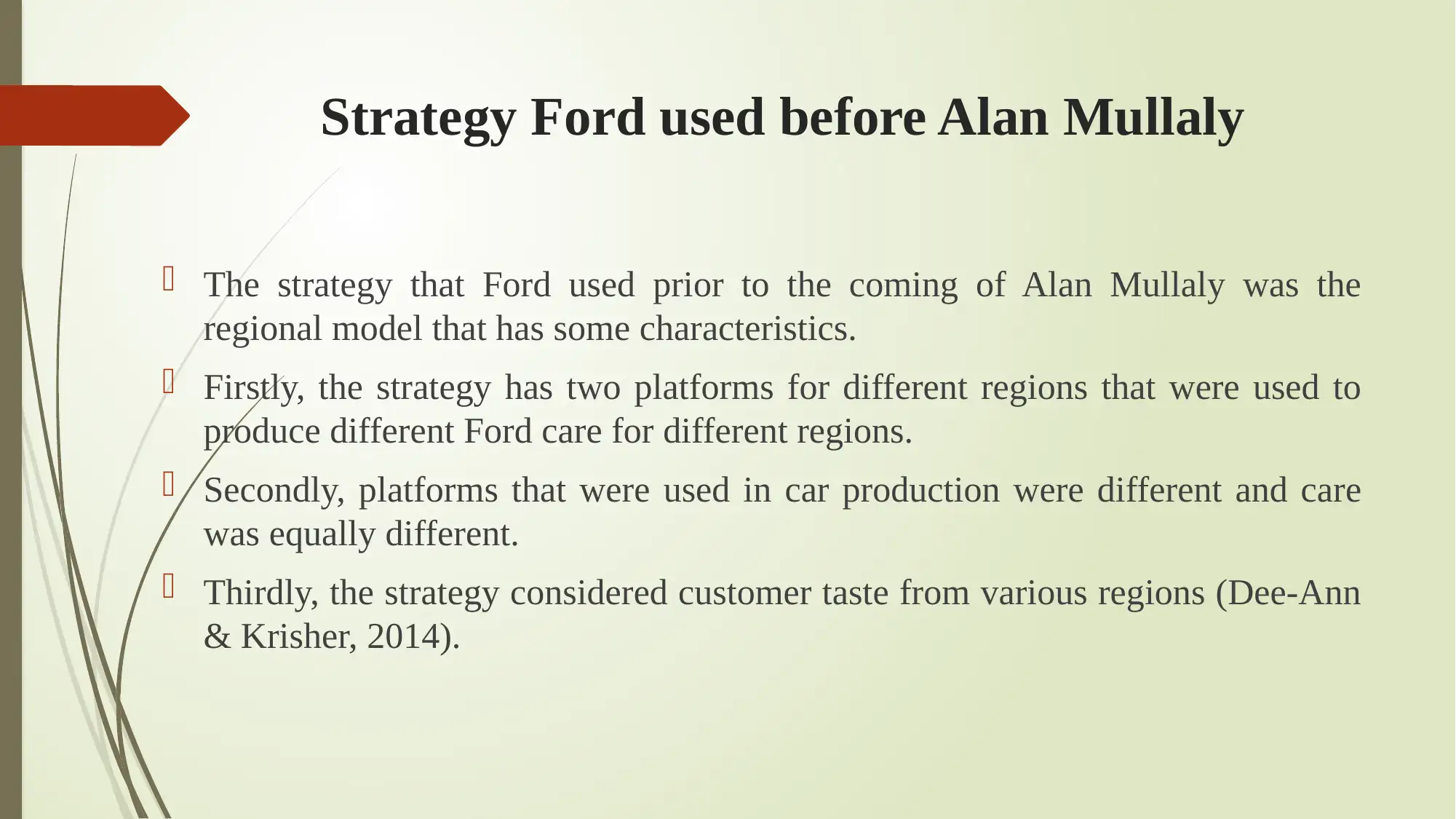
Strategy Ford used before Alan Mullaly
The strategy that Ford used prior to the coming of Alan Mullaly was the
regional model that has some characteristics.
Firstly, the strategy has two platforms for different regions that were used to
produce different Ford care for different regions.
Secondly, platforms that were used in car production were different and care
was equally different.
Thirdly, the strategy considered customer taste from various regions (Dee-Ann
& Krisher, 2014).
The strategy that Ford used prior to the coming of Alan Mullaly was the
regional model that has some characteristics.
Firstly, the strategy has two platforms for different regions that were used to
produce different Ford care for different regions.
Secondly, platforms that were used in car production were different and care
was equally different.
Thirdly, the strategy considered customer taste from various regions (Dee-Ann
& Krisher, 2014).
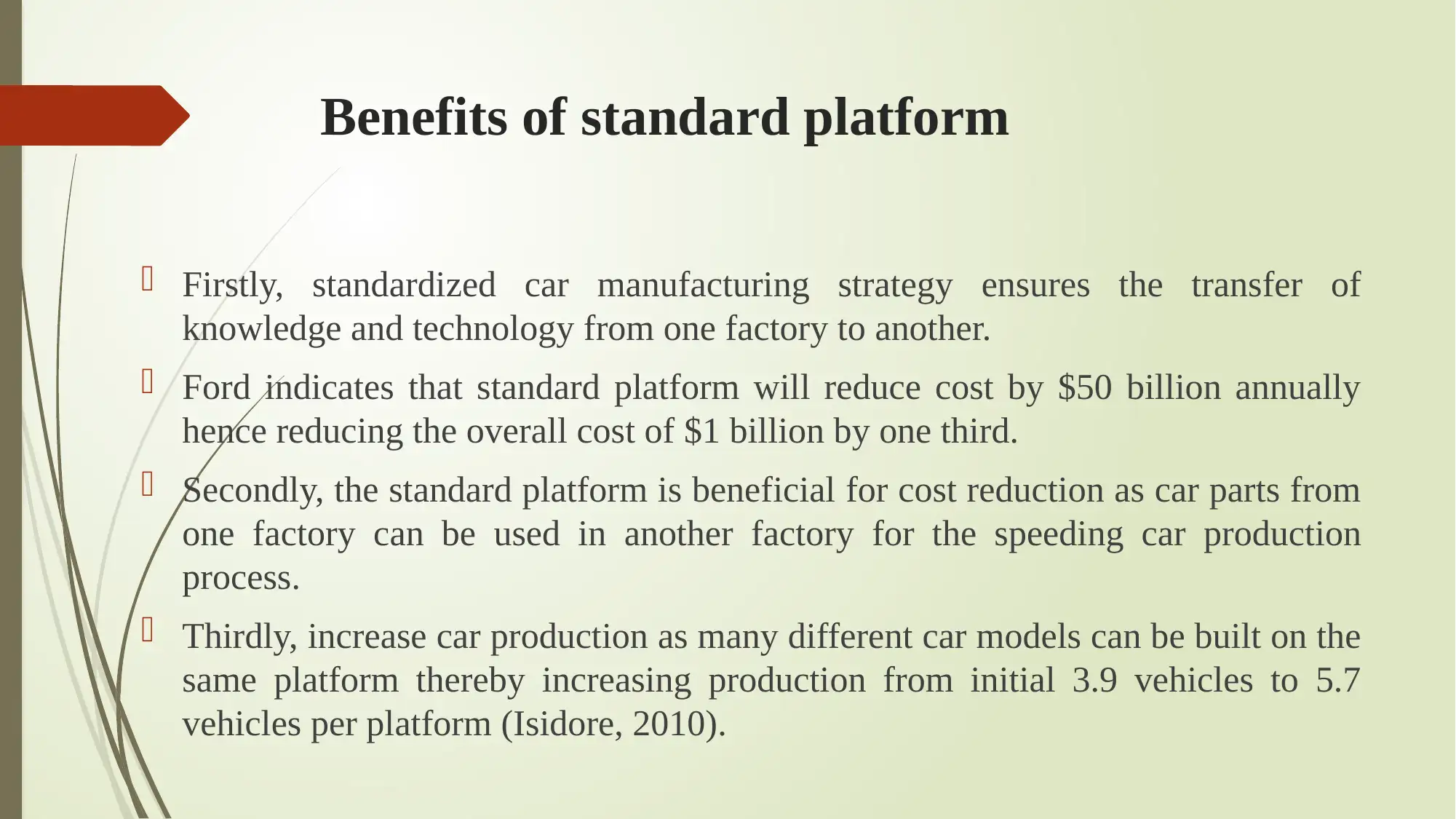
Benefits of standard platform
Firstly, standardized car manufacturing strategy ensures the transfer of
knowledge and technology from one factory to another.
Ford indicates that standard platform will reduce cost by $50 billion annually
hence reducing the overall cost of $1 billion by one third.
Secondly, the standard platform is beneficial for cost reduction as car parts from
one factory can be used in another factory for the speeding car production
process.
Thirdly, increase car production as many different car models can be built on the
same platform thereby increasing production from initial 3.9 vehicles to 5.7
vehicles per platform (Isidore, 2010).
Firstly, standardized car manufacturing strategy ensures the transfer of
knowledge and technology from one factory to another.
Ford indicates that standard platform will reduce cost by $50 billion annually
hence reducing the overall cost of $1 billion by one third.
Secondly, the standard platform is beneficial for cost reduction as car parts from
one factory can be used in another factory for the speeding car production
process.
Thirdly, increase car production as many different car models can be built on the
same platform thereby increasing production from initial 3.9 vehicles to 5.7
vehicles per platform (Isidore, 2010).
⊘ This is a preview!⊘
Do you want full access?
Subscribe today to unlock all pages.

Trusted by 1+ million students worldwide
1 out of 17
Related Documents
Your All-in-One AI-Powered Toolkit for Academic Success.
+13062052269
info@desklib.com
Available 24*7 on WhatsApp / Email
![[object Object]](/_next/static/media/star-bottom.7253800d.svg)
Unlock your academic potential
Copyright © 2020–2025 A2Z Services. All Rights Reserved. Developed and managed by ZUCOL.





